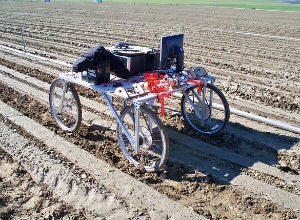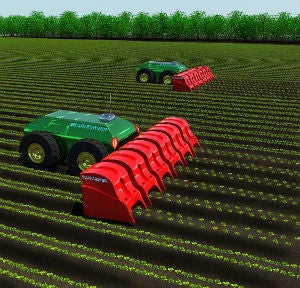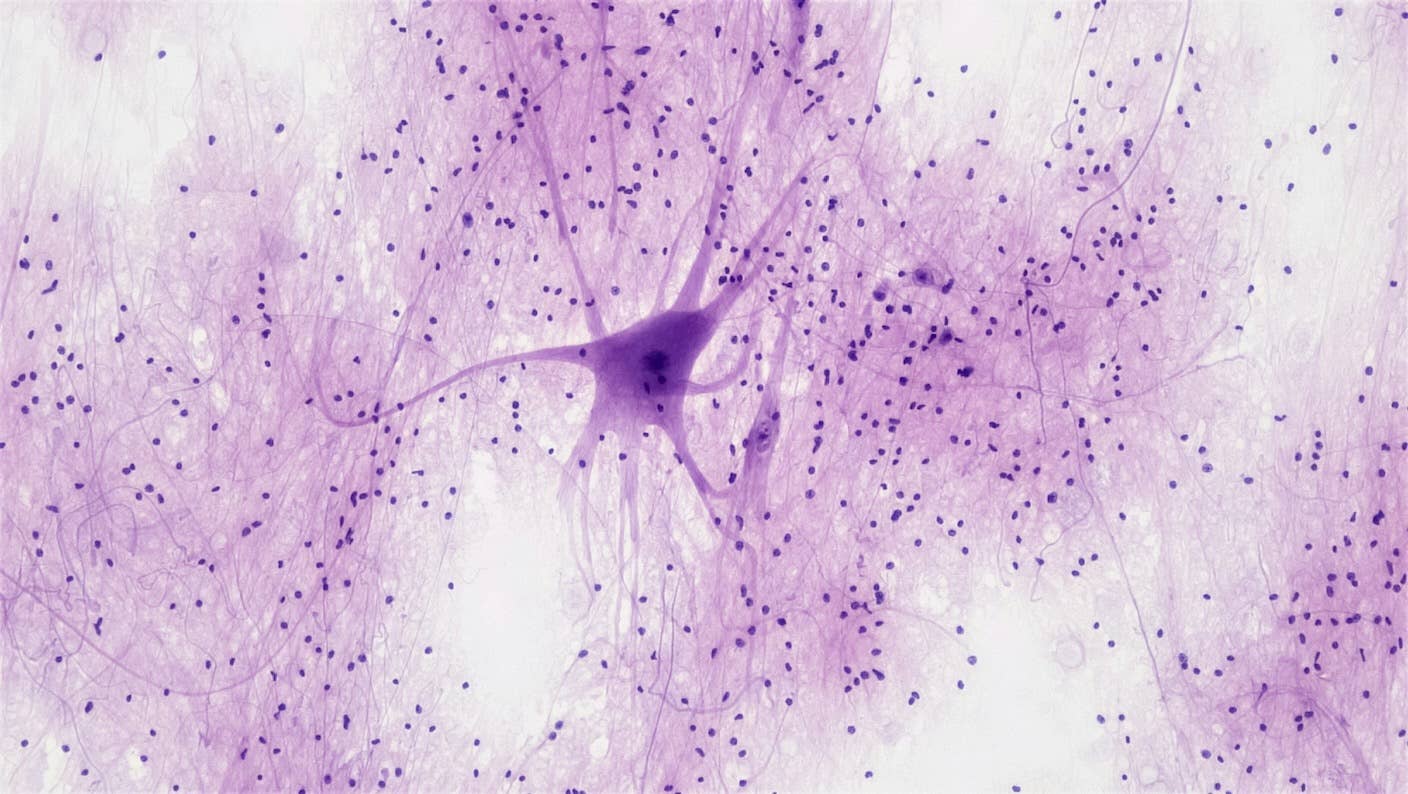“Lettuce Bot” Rolls Through Crops, Terminates Weeds It Visually Identifies

Share

This earlier prototype of "Lettuce Bot" allowed Blue River to hone its weed identifying algorithms.
If food was a superhero (called, I don't know...Captain Nutrient), one of its most dangerous archenemies would be The Vile Weed.
Okay, perhaps that's a juvenile way of explaining how detrimental weeds are to crops, but it does capture the severity of the threat that they present to global food sources. In fact, a 1994 estimate determined that weeds alone caused a loss of 13 percent of agriculture production, and that number today may be higher.
Against this invasive enemy, we have but one weapon -- herbicides. According to a recent report from Transparency Market Research, the global herbicide market was estimated to be about $20 billion in 2011 and expected to grow around 6 percent over the next six years. But spraying chemicals seems like a sloppy, old school method for dealing with weeds, especially when they inevitably develop chemical resistance in their drive for self-preservation. Perhaps what crops need to be free of this nemesis is a humble sidekick, one that can tip the balance in the war playing out amongst rows of tiny trenches splayed across farmer's fields everywhere.
Today, that sidekick has arrived...at least on battlefields growing lettuce, hence its nickname: "Lettuce Bot."
But don't let its humble moniker fool you. Lettuce Bot is a robotic terminator, targeting and selectively killing weeds on sight with 98 percent accuracy. It works by first differentiating weed from lettuce through its vision algorithms and then a trailing component either slices the weed down, injects a minimal dose of herbicide, or hits it with potent fertilizer. The fertilizer offers the best of both worlds in that it is concentrated enough to burn the weed's roots but not so much to kill the lettuce -- plus it provides extra nutrients to the soil.
The initial prototype was built in a wooden housing, but was still able to collect over a million images for analysis. Later, a robot was attached to a tractor and rolled through the fields on wheels. Now, the team wants to get the robot to move at 3 miles per hour while still retaining its accuracy.
Robots in agriculture aren't new. A few years ago, MIT began experimenting with robotic gardeners and there's even a hydroponic lettuce plant in Belgium that is automated. But the real magic of Lettuce Bot is in its object recognition system, which Gigaom reports involves three different algorithms: the first identifies if the camera is observing a plant, the second (called the Classify algorithm) determines if it is a plant or weed, and the third is the kill program that times the exact moment of execution. Here you can see how the camera system identifies the individual plants, even those that are overlapping in an image:
This agricultural robot is the product of Blue River Technology, an Indiana-based startup founded last year by two Stanford alums. The company looks to disrupt the herbicide industry by using sophisticated object recognition through AI instead of broad scale herbicide spraying, potentially reducing its use by as much as 250 million pounds of chemicals in the U.S. annually. Having received $400,000 from angel investors and a $150,000 NSF grant in 2011, the team announced last week it had raised $3.1 million in a Series A round led by Khosla Ventures, which recently invested in the maker of a smartphone otoscope among other potentially disruptive startups. That money is slated to help make Lettuce Bot into a commercial reality.
Be Part of the Future
Sign up to receive top stories about groundbreaking technologies and visionary thinkers from SingularityHub.



Ultimately, the company envisions creating a fleet of driverless vehicles that could pull multiple bots at a time, thereby automating agriculture.
The company initially is targeting organic farming since "Organic farmers do not use herbicides to kill weeds," Jorge Heraud told Kidela last May. He added, "Instead, they hire laborers to pull the weeds out of the ground. It is a slow, tedious process, and one of the reasons why organic agricultural products are so much more expensive than conventional produce." Robots replacing human laborers is not anything new, and adapting the bots into organic practices seems very reasonable. And it would be a modern miracle if organic food prices could be lowered.
Still, Gizmodo reports that the bot currently only works on Iceberg and Romaine lettuces, as the database of stored images was generated for those plants only. Switching to another vegetable will involves building another database to compare images against.
While the lettuce database may have taken a while to generate, new technologies may be employed that will expedite this process. After all, facial recognition software has made enormous strides over the last few years, to the point that now a surveillance system can sort through 36 million images a second to find a face. Furthermore, this isn't the first instance of using visual recognition in agriculture. Last year, Japanese researchers developed a robot that identify ripe strawberries amongst unripe fruit using stereoscopic cameras to identify the berries color.
So it seems reasonable that Blue River will be able to enhance Lettuce Bot with some tricks in time, expanding the weeds it can identify and the fields in can operate within. Though the organic community may be anti-GMO, it certainly would embrace a technology that would allow it to minimize or even eliminate the use of herbicides, even one as high tech as a robot. But the robot is not limited to organic farming either, as herbicide-resistant weeds are a widespread problem. Chemicals have been resorted to simply because people cannot be combing fields around the clock, but a robot could.
Down the road, a robot working a field could do more than just visually recognize weeds. It could also catalog insects it observes and identify pests. Functionality could be expanded to include testing of soil pH, nitrogen levels, and water content. Taking some inspiration from the lab-on-wheels design of the Curiosity rover currently on Mars could also inspire a whole generation of agricultural robots that could tend a field to near perfection.
Altogether, robots like Lettuce Bot are sure to be part of the future of food. But, like any good sidekick, they'll take the road of humility and work quietly in the background to make the world safe.
David started writing for Singularity Hub in 2011 and served as editor-in-chief of the site from 2014 to 2017 and SU vice president of faculty, content, and curriculum from 2017 to 2019. His interests cover digital education, publishing, and media, but he'll always be a chemist at heart.
Related Articles

In Wild Experiment, Surgeon Uses Robot to Remove Blood Clot in Brain 4,000 Miles Away

A Squishy New Robotic ‘Eye’ Automatically Focuses Like Our Own

This Crawling Robot Is Made With Living Brain and Muscle Cells
What we’re reading
